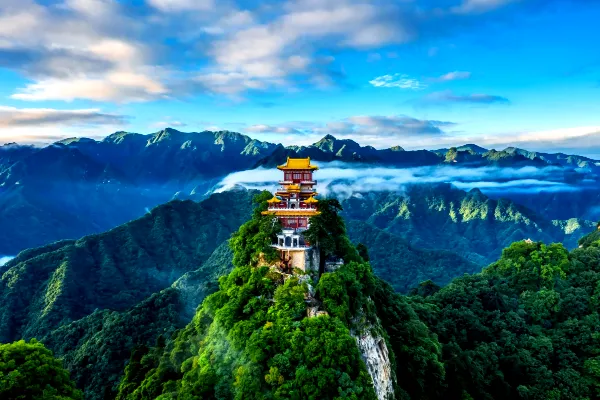
Located in Wutai County, Xinzhou City, Shanxi Province, Wutai Mountain is the foremost of China's Four Sacred Buddhist Mountains and one of the world's Five Great Buddhist Holy Sites. It blends Buddhist culture, ancient architecture and natural scenery, and was inscribed on UNESCO's World Heritage List in 2009.
Overview
Basic Information
- Terrain Features: Composed of five flat-topped peaks (hence the name "Wutai" meaning "Five Terraces").
- Area: Planned area of 607 sq km, with core scenic area covering 184 sq km.
Buddhist Significance
- Manjushri's Sacred Site: Foremost Buddhist mountain in China, abode of Manjushri Bodhisattva.
- Temples: 47 existing monasteries, including Foguang Temple and Xiantong Temple which are national key cultural relics.
- History: Buddhism introduced during Eastern Han Dynasty, flourished in Tang Dynasty, with earliest existing buildings dating back to Tang era.
Main Attractions
Five Terraces
- East Terrace (Wanghai Peak): 2,795m altitude, best spot for sea of clouds and sunrise.
- South Terrace (Jinxiu Peak): 2,485m, carpeted with wild flowers in summer.
- West Terrace (Guayue Peak): 2,773m, famous for moon viewing.
- North Terrace (Yedou Peak): 3,061m, highest peak in North China.
- Central Terrace (Cuiyan Peak): 2,894m, spectacular rock formations.
Famous Temples
- Xiantong Temple: Largest temple in Wutai, built during Eastern Han Dynasty.
- Tayuan Temple: Landmark Great White Pagoda stands 56.4m tall.
- Pusa Ding: Imperial temple of Qing Dynasty, seat of Tibetan Buddhist leaders.
- Foguang Temple: Exemplar of Tang Dynasty wooden architecture, hailed by Liang Sicheng as "China's No.1 National Treasure".
Featured Experiences
Buddhist Culture
- Pilgrimage Circuit: Hike or drive to worship at all five terraces ("Great Pilgrimage").
- Religious Ceremonies: Daily morning/evening chanting, Buddha's birthday celebrations.
- Meditation Retreats: Some temples offer short-term meditation and Buddhist lectures.
Natural Scenery
- Alpine Meadows: Beautiful grassland scenery in summer with cool climate.
- Sea of Clouds: Spectacular cloud formations after rain.
- Stargazing: Ideal location due to high altitude and clear air.
Practical Information
Opening Hours
- Open Year-round: Temple complex open all day, individual temples 06:00-19:00.
- Best Season: June to September (July average temp. only 19°C).
Ticket Information
- Peak Season(Apr 1-Oct 31): 135 RMB/person
- Off Season(Nov 1-Mar 31): 118 RMB/person
- Eco-bus: 50 RMB/person (unlimited rides)
Transportation
- Public Transport: Direct buses from Taiyuan East Bus Station.
- Self-drive: From Taiyuan via Erguang and Cangyu Expressways.
- Internal Transport: Eco-buses connect major sites; private vehicles must park in designated areas.
Travel Tips
- Itinerary: Allow at least 2 days - one for Taihuai Town temples, one for terrace pilgrimage.
- Equipment: Bring windproof jacket and hiking shoes for changeable mountain weather.
- Etiquette: Respect Buddhist customs - no loud noises or inappropriate clothing in temples.